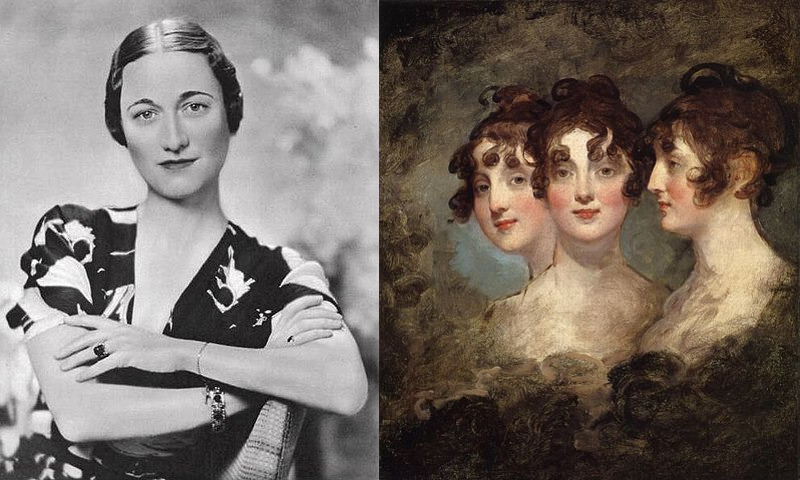
By now, the whole world knows that American actress Meghan Markle will marry Britain’s Prince Harry in May. Congratulations to the happy couple.
Also by now, many outlets have pointed out that Markle is not the first Yank to marry into the ranks of royalty. Previous trailblazers include fellow actress Grace Kelly (Monaco) and socialites Lee Bouvier (Poland) and Marie Chantal-Miller (Denmark/Greece). Plus, as we all learned from Downton Abbey, marrying American heiresses was all the rage among the British upper class in the late 19th and early 20th centuries, as venerable British families sought new American fortunes to prop up their money pit estates. In other words, there’s a long precedent of transatlantic marriages, for any number of reasons, including love.
But what many may not know is that two Baltimore women are among the more colorful members of this elite tradition.
The first, Elizabeth “Betsy” Patterson Bonaparte, was the daughter of a prominent Baltimore merchant who, at one point, was the second richest man in Maryland.
In 1803, Betsy, who was known for her style, vivacity, and beauty, married Napoleon’s youngest brother, Jérome. The marriage was plagued almost from the start. Napoleon disapproved of the union and urged his brother to annul it. When the couple sailed for Europe in 1804, Napoleon forbid Betsy—by then pregnant with the couple’s only child—from disembarking. Her husband pledged to procure Napoleon’s acceptance, but was unsuccessful and quickly gave up, abandoning his pregnant young bride. Betsy found sanctuary in London, where she gave birth to a son, Jerome Napoleon Bonaparte (called Bo), in 1805. But save for one brief encounter in 1817, she never saw her husband again. (She was granted a divorce from him in 1815 by special act of the Maryland legislature.)
But don’t cry for Betsy. The irrepressible heiress returned to Baltimore where she successfully managed her family’s estate and remained a figure of fascination, even making a return visit to Europe at one point where she was warmly welcomed by high society. She died in 1879 at the ripe old age of 94 and is buried in Green Mount Ceremony where her tombstone reads: “After life’s fitful fever she sleeps well.”
The second—and even more controversial—Baltimorean to infiltrate European royal society was Wallis Simpson, who fell in love with the man who would become King Edward VIII in the early 1930s, and nearly toppled the British monarchy in the process.
Simpson was born Bessie Wallis Warfield just over the Pennsylvania-Maryland line in June 1896. Her father died of tuberculosis shortly thereafter and she grew up in Baltimore, bouncing from one address to another with her widowed mother. For a period of time around 1905, she and her mother lived in a room at what is now Hotel Brexton on Park Avenue in Mt. Vernon. Thanks to generous relations, including her uncle and one-time Baltimore postmaster Solomon Davies Warfield, she attended the elite Oldfields School in Sparks-Glencoe, where she excelled socially and academically.
When she became the mistress of then-Prince Edward in 1934, she was already on her second marriage. That marriage, to British shipping magnate Ernest Aldrich Simpson, would end in divorce in 1937, by which time Prince Edward’s father, King George V, had died and Edward had ascended to the throne. The new king marrying an American of no particular fortune or lineage was already an undesirable prospect, but, as the head of the Church of England, the king marrying a twice-divorced American of no particular lineage and fortune was out of the question. In December 1936, King Edward VIII abdicated the throne, telling the British public in a radio address that he “found it impossible to carry the heavy burden of responsibility, and to discharge my duties as King as I would wish to do, without the help and support of the woman I love.”
Though the story was spun as one of gallantry and love, the reality was much more complicated, with Wallis and Edward—now dubbed the Duke and Duchess of Windsor—living as glamorous exiles the rest of their lives. And while there does seem to have been a genuine bond between the two, royal watchers have long gossiped that the relationship was unhealthy with Wallis acting as a domineering mommy/mistress figure to the feckless, resentful Edward. It has also been said that the Duke and Duchess were Nazi sympathizers, which further tarnished their reputations. (For interesting portrayals of the Duke and Duchess, see Netflix’s The Crown or the Oscar-winning The King’s Speech.)
So, you know, maybe it’s a good thing Meghan’s from California and not Baltimore. We don’t seem to have the best track record with royal weddings.
